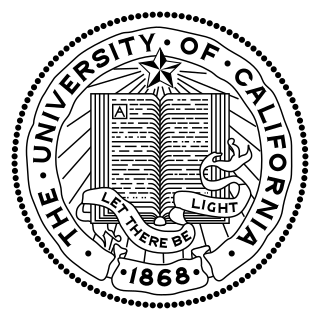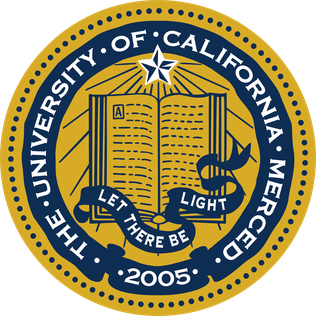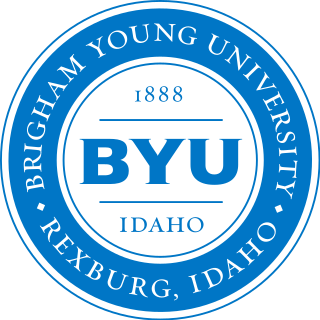Related Research Articles

The University of California (UC) is a public land-grant research university system in the U.S. state of California. Headquartered in Oakland, the system is composed of its ten campuses at Berkeley, Davis, Irvine, Los Angeles, Merced, Riverside, San Diego, San Francisco, Santa Barbara, and Santa Cruz, along with numerous research centers and academic abroad centers. The system is the state's land-grant university. Major publications generally rank most UC campuses as being among the best universities in the world. In 1900, UC was one of the founders of the Association of American Universities and since the 1970s seven of its campuses, in addition to Berkeley, have been admitted to the association. Berkeley, Davis, Santa Cruz, Irvine, Los Angeles, Santa Barbara, and San Diego are considered Public Ivies, making California the state with the most universities in the nation to hold the title. UC campuses have large numbers of distinguished faculty in almost every academic discipline, with UC faculty and researchers having won 71 Nobel Prizes as of 2021.

The University of California, Los Angeles (UCLA) is a public land-grant research university in Los Angeles, California, United States. Its academic roots were established in 1881 as a normal school then known as the southern branch of the California State Normal School which later evolved into San José State University. The branch was transferred to the University of California to become the Southern Branch of the University of California in 1919, making it the second-oldest of the ten-campus University of California system after the University of California, Berkeley.

The California State University is a public university system in California, and the largest public university system in the United States. It consists of 23 campuses and seven off-campus centers, which together enroll 457,992 students and employ 56,256 faculty and staff members. In California, it is one of the three public higher education systems, along with the University of California and the California Community Colleges systems. The CSU system is officially incorporated as The Trustees of the California State University, and is headquartered in Long Beach, California.

The University of California, Riverside is a public land-grant research university in Riverside, California. It is one of the ten campuses of the University of California system. The main campus sits on 1,900 acres (769 ha) in a suburban district of Riverside with a branch campus of 20 acres (8 ha) in Palm Desert. In 1907, the predecessor to UCR was founded as the UC Citrus Experiment Station, Riverside which pioneered research in biological pest control and the use of growth regulators.

The University of California, Merced is a public land-grant research university in Merced, California. It is one of the ten campuses in the University of California (UC) system. Established in 2005, UC Merced is the newest campus within the UC system. The primary campus is located around five miles north of Merced and sits adjacent to Lake Yosemite. The main campus is around 1,026 acres in size, and total land owned by the university amounts to around 8,195 acres including large areas of preserve land. Large swaths of almond orchards and natural grasslands surround the university.

Brigham Young University–Idaho is a private college in Rexburg, Idaho. Founded 136 years ago in 1888, the college is owned and operated by the Church of Jesus Christ of Latter-day Saints. Previously known as Ricks College, it transitioned from a junior college to a baccalaureate institution in 2001.
An academic term is a portion of an academic year during which an educational institution holds classes. The schedules adopted vary widely. Specific synonyms are commonly used to denote the duration or a term. In most countries, the academic year begins in late summer or early autumn and ends during the following spring or summer.

Robert Joseph Birgeneau is a Canadian-American physicist and university administrator. He was the ninth chancellor of the University of California, Berkeley from 2004–13, and the fourteenth president of the University of Toronto from 2000-04.

California State University, Sacramento is a public university in Sacramento, California. Founded in 1947 as Sacramento State College, it is part of the California State University system.
"Public Ivy" is an informal term that refers to public colleges and universities in the United States that are perceived to provide a collegiate experience on the level of Ivy League universities. There is no trademark for the term, and the list of schools associated with the classification has changed over time.
A course credit is a measure of the size of an educational course, often used to determine whether the requirements for an award have been met, to facilitate transfer between institutions, or to enhance intercomparability of qualifications. Credit may be input-based – defined by the quantity of instruction given – or outcome-based – defined by the learning outcomes and a notional time to achieve those outcomes.

The California Community Colleges is a postsecondary education system in the U.S. state of California. Despite its plural name, the system is consistently referred to in California law as a singular entity. The system includes the Board of Governors of the California Community Colleges and 73 community college districts. The districts currently operate 116 accredited colleges. The California Community Colleges is the largest system of higher education in the United States, and third largest system of higher education in the world, serving more than 1.8 million students.

Woodrow Wilson High School is an American public high school located in Long Beach, California. This two-block campus is located approximately 1.5 miles from the Pacific Ocean, across from the Recreation Park, and approximately 3 miles from Orange County.

St. John Bosco High School (SJBHS) is a Salesian, all-boys college preparatory high school located in Bellflower, California, and is operated by the San Francisco Province of the order.
The Carnegie Unit and the Student Hour are strictly time-based references for measuring educational attainment used by American universities and colleges; the Carnegie Unit assesses secondary school attainment, and the Student Hour, derived from the Carnegie Unit, assesses collegiate attainment.

Charles Edward Young, nicknamed Chuck Young, was an American university administrator and professor. A native of California, Young led the University of California, Los Angeles (UCLA) for 29 years as chancellor and the University of Florida for more than four years as president.
The University of California, Irvine has over fourteen academic divisions.
The University System of Ohio is the public university system of the U.S. state of Ohio. It is governed by the Ohio Department of Higher Education.
In the United States, community colleges are primarily two-year public institutions of tertiary education. Community colleges offer undergraduate education in the form of an associate degree. In addition community colleges also offer remedial education, GEDs, high school diplomas, technical diplomas and tech certificates, and in rare cases, a limited number of 4-year bachelor's degrees. After graduating from a community college, some students transfer to a four-year college or university to continue their studies leading to a bachelor's degree. Community college is tuition-free for selected students in 47 states, often under the name College Promise. Most community college instructors have advanced degrees but serve as part-time low wage employees.

Glenn Schroeder Dumke was an American historian, educator, university president, and chancellor of the California State University system. Dumke was the 6th President of San Francisco State University, serving from 1957 to 1961. He served as the second chancellor of the California State University system from 1962 to 1982, for most of its first twenty years. He developed common standards for the colleges and universities in the system, supported affirmative action to recruit women and minority students, and assisted the establishment of four new campuses.
References
- ↑ "University of Oxford - History". University of Oxford. Retrieved 2016-07-16.
- ↑ "University of Cambridge - History". University of Cambridge. 2013-01-28. Retrieved 2016-07-16.
- ↑ "Practice Resources, NAFSA: Association of International Educators". Archived from the original on 2008-05-03. Retrieved 2008-08-07.
- 1 2 Kemp Malone, 'Semester' , American Speech, Dec. 1946, p. 264
- 1 2 3 4 Report of the 1998-99 ad hoc Calendar Committee, Northeastern University, July 30, 1999 [ permanent dead link ]
- ↑ H.W. James, The Semester versus the Quarter, Journal of Higher Education, Oct. 1930, p. 38
- ↑ "Ensuring Access with Quality to California's Community Colleges". The National Center for Public Policy and Higher Education. Archived from the original on 21 February 2020. Retrieved 7 March 2021.
{{cite web}}: CS1 maint: unfit URL (link) - ↑ Lum, Lydia (2 June 2004). "Too Fast, Too Furious? As community colleges grow in enrollment and appeal, some question their ability to serve disadvantaged students". Diverse Issues in Higher Education. Retrieved 7 March 2021.
- ↑ "University proposes master plan". The Daily Aztec. 21 October 2004. Retrieved 7 March 2021.
- 1 2 3 4 Debate: Semesters or Quarters, UCLA Faculty Senate Voice, Apr. 2003 (iss. 3) Archived February 21, 2008, at the Wayback Machine
- ↑ Harlan Lebo, Semester vs. quarter?, UCLA Today, 2002 Archived August 7, 2008, at the Wayback Machine
- 1 2 3 Robbins, Gary (February 19, 2020). "UC San Diego might switch to semester system to ease stress on students". San Diego Union-Tribune . Retrieved February 20, 2020.
- ↑ Chris Ziegler, Faculty Considers Switch from Quarter to Semester, (University of California, Santa Barbara) Daily Nexus, Jan. 29, 1990 (reprinted Jan. 29, 2007) Archived May 25, 2008, at the Wayback Machine
- ↑ Farkas, Karen (May 30, 2012). "State universities, community colleges switching from quarters to semesters". Cleveland.com . Retrieved February 20, 2020.
- ↑ Rich Rouan, OU Ready to Consider Switch to Semesters, Columbus Dispatch, June 26, 2008
- ↑ University of Cincinnati planning switch to semesters, Business Courier of Cincinnati, Apr. 29, 2008
- ↑ Hoyt Coffee, Regents Set Semester Switch, Georgia Tech Alumni magazine, Spring 1996
- ↑ "RIT Semester Conversion". Archived from the original on 2010-07-25. Retrieved 2010-07-14.
- 1 2 Kestler, Jessica L.; Johnson, Marcus Lee (Summer 2014). "Transitioning from Quarters to Semesters: Changes in College Students' Predicted and Perceived Motivation". College and University. 89 (4). Retrieved February 20, 2020.
- ↑ Darling, John (June 4, 2010). "SOU considers switch to semesters". Mail Tribune . Retrieved February 20, 2020.
- ↑ "Tony Boom, SOU studies semester switch, Mail-Tribune, Apr. 3, 2001". Archived from the original on 2016-03-03. Retrieved 2008-08-07.
- ↑ Relating to university consolidation and declaring an emergency (Chapter 801). House Bill 442, section 1. Oregon Legislative Assembly. 2009. p. 1.
{{cite report}}: CS1 maint: others (link) - ↑ Sarah Mohajeri, From Semesters to Quarters, in UCLA in the sixties, May 24, 2005 Archived September 12, 2007, at the Wayback Machine
- ↑ Poe, Mariya. "Semester vs Quarter System Explained & Full List of Colleges," College Transitions, Tuesday, July 25, 2023. Retrieved March 9, 2024.